-

新人教版高中英语必修2Unit 3 The Internet-Reading For Writing教案一
⑦identity theft 身份盗窃⑧chat room 聊天室⑨draft your blog post 起草博客帖子⑩post embarrassing photos 张贴尴尬照片 【话题句式】 1. How do you stay safe online and avoid bad experiences on the Internet? 你如何在网上保持安全, 避免在网上的不良经历? 2. I’m not an expert, but many years as a blogger have taught me a thing or two. 我不是专家, 但作为一个博主, 我已经学了好几年了。 3. If you see or read something that makes you feel uncomfortable, leave the site immediately. 如果你看到或读到一些让你觉得不舒服的东西, 立即离开这个网站。4. Don’t give out your address or phone number. 别告诉别人你的地址或电话号码。 5. Identity theft is a common and serious problem. 身份盗窃是一个常见而严重的问题。6. Being online is no excuse for being rude, and you don’t want to become a target for a troll or cyberbully. 上网并不是无礼的借口, 你也不想成为发挑衅帖子的人或网络恶霸的目标。 7. Trolls often use several false names so that they can stay on a site. 发挑衅帖子的人经常使用几个假名, 这样他们就可以留在一个网站上。8. However, the more polite you are, the less likely it is you will be attacked. 然而, 你越有礼貌, 你被攻击的可能性就越小。

新人教版高中英语必修2Unit 4 History and Traditions-Listening&Speaking&Talking教案二
Listening and Speaking introduces the topic of “Take part in a youth project”. The listening text is an interview about "sharing views on historical sites". Through listening to a dialogue between Chinese and foreign students on the way to the Confucius Temple, students can understand their views on the Confucius Temple, Confucius, Confucius' descendants and Confucius' educational thoughts, so as to realize and think about the profound influence of Confucius and his thoughts on Chinese historical tradition. At the same time, the dialogue naturally integrates English idioms and mentions Shakespeare, the British playwright, so as to provide language materials and context for students to understand English idioms and related cultural allusions, as well as to compare Chinese and foreign cultures, which is helpful for students to understand and express the language such as history, tradition, culture and custom significant impact.Text analysis: listening text is a dialogue between a British student and a Chinese student when he goes to the Confucius Temple. When William, a British student, visited the Confucius Temple, he asked Xiao Kong, a Chinese student, for directions. Xiao Kong was just going to the Confucius Temple to meet with the members of the research group, so they went together and exchanged their views on the Confucius Temple, Confucius, Confucius' descendants and Confucius' educational thoughts. From the perspective of foreign tourists, this paper describes their thoughts on Confucius, the great son of Confucius, who had a profound impact on Chinese history and cultural tradition, and his education.Listening and Talking introduces a visit to a historic tourist destination. Tourism is a common way to understand a country's history, culture, and customs and so on. Students listen to the dialogue between Xiao Yan, a youth hostel Usher, and Paul, a backpacker, to learn about Pingyao's famous historical and cultural attractions and Paul's travel experience and experience as a foreign tourist.

新人教版高中英语必修2Unit 4 History and traditions教案
这个地区有着深厚的传统。既学既练:为了让更多的外国游客了解中国文化,欣赏中国美丽的自然风光,感受中国发生的巨大变化,某外文杂志社将出版一本英语小册子来介绍中国的旅游景点。该杂志社邀请你为该小册子写一篇英语短文来介绍杭州,内容包括:1.杭州的位置(中国东南部)、面积(16 000多平方公里)及历史(2 200多年)等;2.杭州的旅游特色(自然风景、传统文化、特色小吃等);3.希望更多的游客来杭州参观。注意:1.词数80左右;2.可适当增加细节,以使行文连贯。Located in the southeast of China, Hangzhou is a beautiful city.Dating back more than 2,200 years, Hangzhou covers an area of more than 16,000 square kilometers.In Hangzhou, you can visit the West Lake, whose scenery is fascinating.In addition, you can’t miss its cultural relics and historical sites, from which you will learn more about excellent Chinese traditional culture and traditions.In Hangzhou, the special snacks are famous and visitors from different parts of the world think highly of them.As a tourist attraction, Hangzhou attracts a large number of visitors from home and abroad every year.Once you come to China, Hangzhou is a scenic spot you can’t miss.

新人教版高中英语必修2Unit 5 Music-Discovering Useful Structures教案一
Step1:自主探究。1.(教材P52)Born(bear) in the USA on 2 January 1970, Whitacre began studying music at the University of Nevada in 1988.2.(教材P52) Moved(move) by this music, he said, “It was like seeing color for the first time.”3.(教材P56)I was very afraid and I felt so alone and discouraged(discourage).4.(教材P58)Encouraged(encourage) by this first performance and the positive reaction of the audience, I have continued to play the piano and enjoy it more every day.Step2:语法要点精析。用法1:过去分词作表语1).过去分词可放在连系动词be, get, feel, remain, seem, look, become等之后作表语,表示主语所处的状态Tom was astonished to see a snake moving across the floor.汤姆很惊讶地看到一条蛇正爬过地板。Finally the baby felt tired of playing with those toys.终于婴儿厌倦了玩那些玩具。注意:1).过去分词作表语时与被动语态的区别过去分词作表语时,强调主语所处的状态;而动词的被动语态表示主语是动作的承受者,强调动作。The library is now closed.(状态)图书馆现在关闭了。The cup was broken by my little sister yesterday.(动作)昨天我妹妹把杯子打碎了。2)感觉类及物动词的现在分词与过去分词作表语的区别过去分词作表语多表示人自身的感受或事物自身的状态,常译作“感到……的”;现在分词多表示事物具有的特性,常译作“令人……的”。
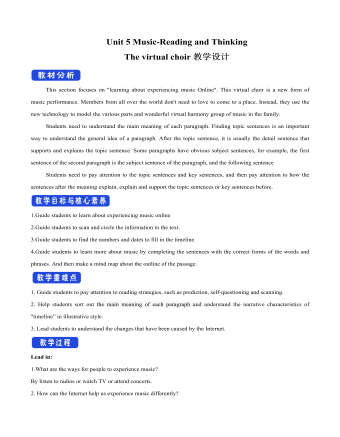
新人教版高中英语必修2Unit 5 Music-Reading and Thinking教案一
This section focuses on "learning about experiencing music Online". This virtual choir is a new form of music performance. Members from all over the world don't need to love to come to a place. Instead, they use the new technology to model the various parts and wonderful virtual harmony group of music in the family. Students need to understand the main meaning of each paragraph. Finding topic sentences is an important way to understand the general idea of a paragraph. After the topic sentence, it is usually the detail sentence that supports and explains the topic sentence. Some paragraphs have obvious subject sentences, for example, the first sentence of the second paragraph is the subject sentence of the paragraph, and the following sentenceStudents need to pay attention to the topic sentences and key sentences, and then pay attention to how the sentences after the meaning explain, explain and support the topic sentences or key sentences before.1.Guide students to learn about experiencing music online2.Guide students to scan and circle the information in the text.3.Guide students to find the numbers and dates to fill in the timeline.4.Guide students to learn more about music by completing the sentences with the correct forms of the words and phrases. And then make a mind map about the outline of the passage.1. Guide students to pay attention to reading strategies, such as prediction, self-questioning and scanning.2. Help students sort out the main meaning of each paragraph and understand the narrative characteristics of "timeline” in illustrative style.3. Lead students to understand the changes that have been caused by the Internet.

新人教版高中英语选修3Unit 2 Healthy Lifestyle教案
Activity 4: Figuring out the structure and the writing purpose 本活动为实现课时目标2。 1.Read Paragraph 6 and think about its main idea and the writer’s writing purpose. Q1: If you were the author, how would you end your article? “For young people, there is plenty of time to change bad habits. However, there is no “magic pill” or delete button that will help you; you have to think about your bad habits and decide on some changes. You have the power to build a happy and healthy life full of good habits!” Q2: What is Paragraph 6 mainly about? (Possible answer: to appeal to young people including teenagers to change bad habits and live a happy and healthy life.) 2.Think about the writer’s writing purpose and share opinions. Q1: What is the writing purpose? Work in pairs and figure it out. (Possible answer: On the one hand, the passage is written to help teenagers change their bad habits and live a healthy lifestyle. On the other hand, it provides us with a scientific way to identify and analyse our problems objectively, thus strengthening our resolve to tackle the seemingly common yet tough problems in our lives.) 【设计意图】 步骤1旨在预测和验证文章最后一段主要内容,梳理完整的语篇结构,步骤2旨在思考和讨论作者的写作目的。教师也可根据学生课堂反应情况融入对语篇人称多次转换的思考。

新人教版高中英语选修4Unit 2 Iconic Attractions教案
帮助学生通过讨论与对主题的提升,反思自己的旅游方式,以便做出更优化的安排,在今后的旅程中有更多的收益。 Activity 2: Further discussion of the 6 elements above and supplement of more background knowledge 本活动为实现课时教学目标2。 1.Target Q: The writer’s clear target of traveling, meeting the people and experiencing the culture, is closely related to his major in social studies. Then what is social studies? Social studies is a part of a school or college curriculum concerned with the study of social relationships and the functioning of society and usually made up of courses in history, government, economics, civics, sociology, geography, and anthropology. (Dictionary by Merriam-Webster) Reflection: When you go out to travel, what targets do you usually have in mind? 2.Research Q: Suppose you are traveling to Hangzhou during the school holidays, how will you do research on the city? (surf the internet, read books or travel brochures, consult friends, ...) What information will you be interested to know? (location, iconic sites, local cuisines, interesting customs, shopping malls ...) 3.Abandonment To make the most of time, we have to learn to abandon so that we can accomplish our plan. What will you be interested in doing if you go to Hangzhou if you have a week’s time? What if you only have 2 days? 4~5. Venturing & Experiencing Q: What did he venture to do during the trip? What new experiences did he have? In Sydney: attend his first open-air barbecue, enjoy many different but yummy meals In Catherine: observe the life and customs of the aborigines appreciate their music & try the musical instruments: the didgeridoo
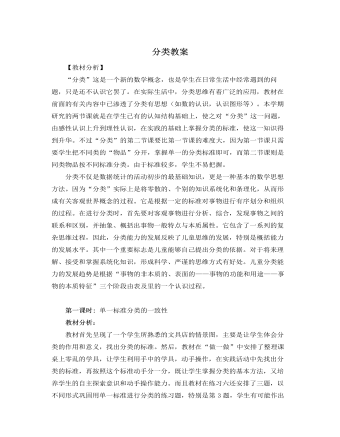
人教版新课标小学数学一年级上册分类教案
教学目标:1.能选择不同的标准对同一类物品进行不同的分类,掌握分类的方法。2.初步感知不同标准分类的意义,体验分类结果在不同标准下的多样性。3.培养学生思维的灵活性和发散性,养成良好的学习、生活习惯。4.培养学生的操作能力、观察能力、判断能力、语言表达能力和合作交流的意识。5.让学生体会到生活中处处有数学,学会用学到的知识解决生活中的实际问题。教学重、难点:重点:选择不同标准分类难点:思维的发散性 关键:在直观中拓展思维的时空教学准备:铅笔、实物卡片、学具袋(各种形状、颜色各异的物品)教学过程:一、观察分析 多重分类1.师出示如书本P39页的铅笔。(1)观察这些铅笔有什么不同?并把它们分分类。(2)四人一小组交流、讨论可以怎么分类?是按什么分的?比比哪一组的分法最多。
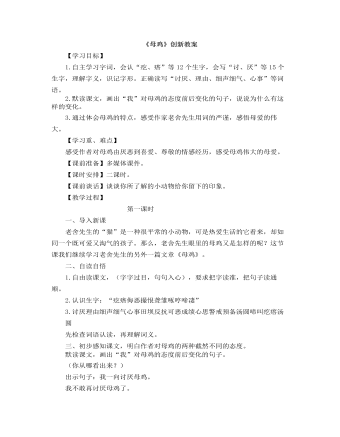
部编人教版四年级下册《母鸡》创新教案
指名学生交流:你选择了是哪个自然段。出示段落(1)不论是在院里,还是在院外,它总是挺着脖儿,表示出世界上并没有可怕的东西。一只鸟儿飞过,或是什么东西响了一声,它立刻警戒起来:歪着头听;挺着身儿预备作战;看看前,看看后,咕咕地警告鸡雏要马上集合到它身边来!你感受到这是一只怎样的母鸡?(勇敢、负责)从文中哪些词语中体会出来。还有同学想说吗?师:从“挺着脖儿、立刻警戒、挺着身儿、咕咕地警告”这些词语我们体会到了勇敢、负责、辛苦的鸡妈妈。现在让我们展开想象的翅膀。想象一下还有哪些情况它立刻警戒起来。(教师口述情境,学生试着说这些词语。)小结:这只母鸡,不论在院里,还是在院外,它总是挺着脖儿。多么负责、勇敢呀!一齐读。

部编人教版四年级下册《天窗》创新教案
【教学设想】1.抓住“小小的天窗是唯一的慰藉。”理解课文内容,了解天窗给乡下小朋友们带来的无尽遐想和无穷快乐。2.作者对天窗的特殊感情,激发学生通过“窗户”看世界的情趣。【教学过程】第一课时(一)激发兴趣,揭示课题1.每栋房子都离不开——窗,可是在近百年前的中国南方农村,窗是怎样的呢?出示课文1—3自然段。(1)读读这三段话,用自己的话说说什么是天窗?人们在屋顶上开天窗的目的是什么?(2)这样一扇简陋的,只能透进些许光亮的天窗却是著名作家茅盾(板书:茅盾)儿时最美好的回忆,于是,他写下了我们今天要学习的散文——天窗。(3)板书课题:天窗(4)齐读课题2.简介茅盾3.天窗为何让茅盾魂牵梦萦?它的魅力在哪里?让我们带着问题走进课文。(二)初读课文,检查预习1.自由读课文,注意生字词的读音,把课文读正确,读流利。2.指名分自然段读课文,读懂每个自然段的意思。3.出示生字、新词,指名认读。
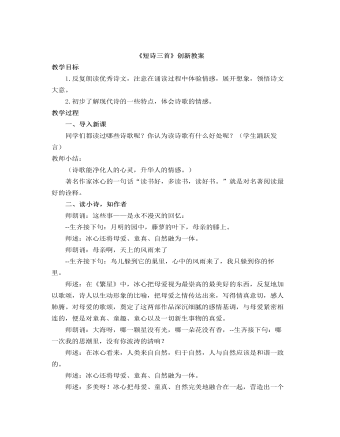
部编人教版四年级下册《 短诗三首》创新教案
教学目标1.反复朗读优秀诗文,注意在诵读过程中体验情感,展开想象,领悟诗文大意。2.初步了解现代诗的一些特点,体会诗歌的情感。教学过程一、导入新课同学们都读过哪些诗歌呢?你认为读诗歌有什么好处呢?(学生踊跃发言)教师小结:(诗歌能净化人的心灵,升华人的情感。)著名作家冰心的一句话“读书好,多读书,读好书。”就是对名著阅读最好的诠释。
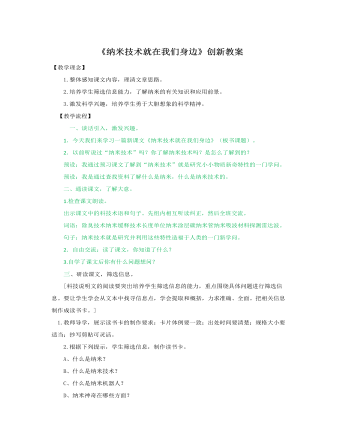
部编人教版四年级下册《 飞向蓝天的恐龙》创新教案
【教学理念】 1.整体感知课文内容,理清文章思路。2.培养学生筛选信息能力,了解纳米的有关知识和应用前景。3.激发科学兴趣,培养学生勇于大胆想象的科学精神。【教学流程】一、谈话引入,激发兴趣。1.今天我们来学习一篇新课文《纳米技术就在我们身边》(板书课题)。2.以前听说过“纳米技术”吗?你了解纳米技术吗?是怎么了解到的?预设:我通过预习课文了解到“纳米技术”就是研究小小物质新奇特性的一门学问。预设:我是通过查找资料了解什么是纳米,什么是纳米技术的。二、通读课文,了解大意。1.检查课文朗读。出示课文中的科技术语和句子。先组内相互听读纠正,然后全班交流。词语:除臭技术纳米缓释技术长度单位纳米涂层碳纳米管纳米吸波材料探测雷达波。句子:纳米技术就是研究并利用这些特性造福于人类的一门新学问。2.自由交流:读了课文,你知道了什么?3.自学了课文后你有什么问题想问?
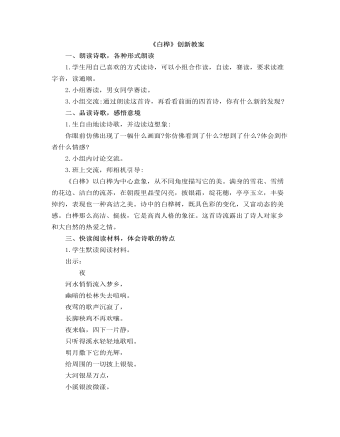
部编人教版四年级下册《白桦》创新教案
一、朗读诗歌,各种形式朗读1.学生用自己喜欢的方式读诗,可以小组合作读,自读,赛读,要求读准字音,读通顺。2.小组赛读,男女同学赛读。3.小组交流:通过朗读这首诗,再看看前面的四首诗,你有什么新的发现?二、品读诗歌,感悟意境1.生自由地读诗歌,并边读边想象:你眼前仿佛出现了一幅什么画面?你仿佛看到了什么?想到了什么?体会到作者什么情感?2.小组内讨论交流。3.班上交流,师相机引导:《白桦》以白桦为中心意象,从不同角度描写它的美。满身的雪花、雪绣的花边、洁白的流苏,在朝霞里晶莹闪亮,披银霜,绽花穗,亭亭玉立,丰姿绰约,表现也一种高洁之美。诗中的白桦树,既具色彩的变化,又富动态的美感。白桦那么高洁、挺拔,它是高尚人格的象征。这首诗流露出了诗人对家乡和大自然的热爱之情。
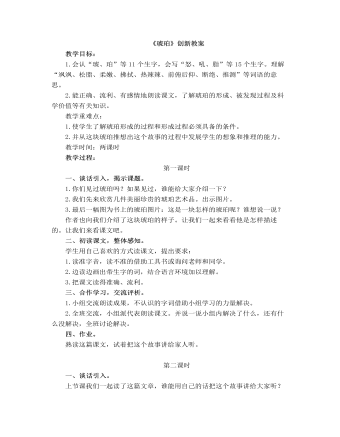
部编人教版四年级下册《琥珀》创新教案
教学重难点:1.使学生了解琥珀形成的过程和形成过程必须具备的条件。2.并从这块琥珀推想出这个故事的过程中发展学生的想象和推理的能力。教学时间:两课时教学过程:第一课时一、谈话引入,揭示课题。1.你们见过琥珀吗?如果见过,谁能给大家介绍一下?2.我们先来欣赏几件美丽珍贵的琥珀艺术品。出示图片。3.最后一幅图为书上的琥珀图片:这是一块怎样的琥珀呢?谁想说一说?作者也向我们介绍了这块琥珀的样子。让我们一起来看看他是怎样描述的。让我们来看课文吧。二、初读课文,整体感知。学生用自己喜欢的方式读课文,提出要求:1.读准字音,读不准的借助工具书或询问老师和同学。2.边读边画出带生字的词,结合语言环境加以理解。3.把课文读得准确、流利。
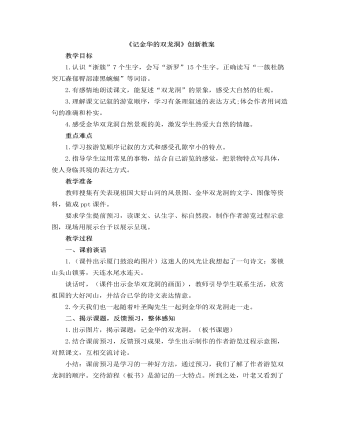
部编人教版四年级下册《记金华的双龙洞》创新教案
教学目标1.认识“浙簇”7个生字,会写“浙罗”15个生字。正确读写“一簇杜鹃突兀森郁臀部漆黑蜿蜒”等词语。2.有感情地朗读课文,能复述“双龙洞”的景象,感受大自然的壮观。3.理解课文记叙的游览顺序,学习有条理叙述的表达方式;体会作者用词造句的准确和朴实。4.感受金华双龙洞自然景观的美,激发学生热爱大自然的情趣。重点难点1.学习按游览顺序记叙的方式和感受孔隙窄小的特点。2.指导学生运用常见的事物,结合自己游览的感觉,把景物特点写具体,使人身临其境的表达方式。教学准备教师搜集有关表现祖国大好山河的风景图、金华双龙洞的文字、图像等资料,做成ppt课件。要求学生提前预习,读课文、认生字、标自然段,制作作者游览过程示意图,现场用展示台予以展示呈现。
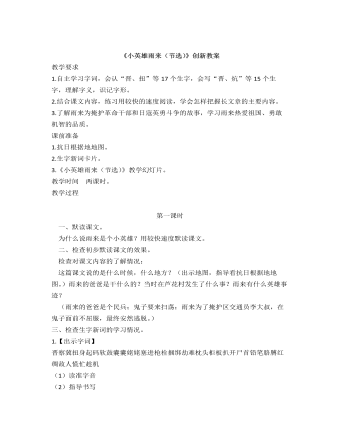
部编人教版四年级下册《小英雄雨来》创新教案
(二)提问:夜校的学习条件怎样?雨来在夜校里受到什么教育?默读第二段。指导朗读:“我们是中国人,我们爱自己的祖国。”“我们——是——中国人,我们——爱——自己的——祖国。”讨论段意和小标题。(段意:雨来上夜校,受到爱国主义教育。)(小标题:“雨来上夜校。”)(三)学习第三段。默读课文,提问:这段主要说了几层意思?学生默读课文,小组交流,展示如下:(两层意思:第一层从“有一天”至“只从街上传来一两声狗叫”,主要写鬼子开始扫荡了;第二层从“第二天”至这段结束,主要写雨来为掩护交通员李大叔,被鬼子捆绑起来了。)指导朗读第二层。重点朗读:“他抬头一看,是李大叔。”“咦!这是什么时候挖的洞呢?”“把缸搬回原地方。你就快到别的院里去,对谁也不许说。”讨论段意和小标题。段意:(雨来为掩护交通员李大叔,被鬼子捆绑起来了。)(小标题:“雨来掩护李大叔”。)
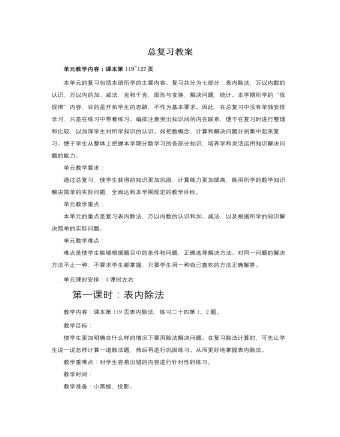
人教版新课标小学数学二年级下册总复习教案
教学时间:教学准备:小黑板,挂图。教学过程:一、复习旧知,引入新课。1、请大家想一想到今天为止,我们已经复习了本学期学过的哪些知识?(表内除法。万以内数的认识和加法、减法。克和千克及图形的变换。)2、对这些知识还有没有什么问题?还有没有内容是我们没有复习到或复习了掌握不好的?如果学生有问题,则针对问题,让同学们一起来想办法解决这些问题。学生提出问题,思考解决方法。二、复习整理:1、分别出示教材第122页第13、14题的挂图。(如果没有,就让学生直接看书)(1)看了图后,你明白图中的画是什么意思吗?学生看挂图,小组讨论这两题的意思。叙述两幅图的意思,没有说好的请其他同学来补充完整。在小组内讨论交流。(2)怎样来解决这两个生活中的实际问题?

人教版新课标小学数学六年级上册统计教案
【新知识点】认识扇形统计图统计填写扇形统计图根据扇形统计图所提供的数据回答问题【单元教学目标】1,认识扇形统计图,了解扇形统计图的特点.2,能够看懂并会填扇形统计图.3,会根据扇形统计图所提供的数据回答一些简单的问题.4,进一步了解统计在实际生活中的地位和作用.5,通过对相关素材的整理和分析,使学生受到一定的思想教育.【单元教学重难点】重点:学生掌握扇形统计图的特点和作用.难点:在学习中体会各种统计图的不同特点.【教学建议】学生已经系统地学习过有关条形统计图和折线统计图的知识,也初步认识了扇形,而且也学习了有关百分数的知识,所有这些都为学校继续学习统计图的最后一部分内容——扇形统计图打下了良好的基础.【课时安排】
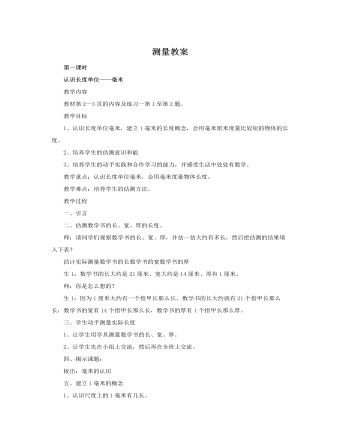
人教版新课标小学数学三年级上册测量教案
教学目标1、认识长度单位毫米,建立1毫米的长度概念,会用毫米厘米度量比较短的物体的长度。2、培养学生的估测意识和能3、培养学生的动手实践和合作学习的能力,并感受生活中处处有数学。教学重点:认识长度单位毫米,会用毫米度量物体长度。教学难点:培养学生的估测方法。教学过程一、引言二、估测数学书的长、宽、厚的长度。师:请同学们观察数学书的长、宽、厚,并估一估大约有多长,然后把估测的结果填入下表?估计实际测量数学书的长数学书的宽数学书的厚生1:数学书的长大约是21厘米、宽大约是14厘米、厚有1厘米。师:你是怎么想的?生1:因为1厘米大约有一个指甲长那么长,数学书的长大约就有21个指甲长那么长,数学书的宽有14个指甲长那么长,数学书的厚有1个指甲长那么厚。
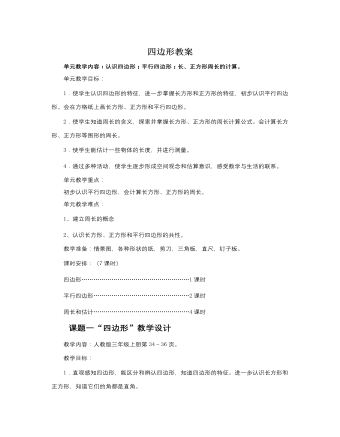
人教版新课标小学数学三年级上册四边形教案
教具、学具准备:各种形状的纸、树叶、绳子、直尺、卷尺等。教学过程:一、今天,老师给大家带来了一些物品和平面图形,你们认识吗?(逐一出示)谁知道周长是什么意思?请你具体指一指,你所喜欢的图形的周长是指什么样的长度。(一生指)二、探究求长方形和正方形周长的计算方法长方形和正方形的周长怎么求呢?正方形的周长只要量一条边长,乘4就可以了。(板书:边长×4)如果量出正方形的边长是5厘米,它的周长是多少?5×4=20(厘米)。长方形的周长呢?量出四条边的长度,加起来就好了。长+宽+长+宽(板书)。如果长是6厘米,宽是4厘米,它的周长就是:6+4+6+4=20(厘米)。只要量两次就可以了,量一个长再乘2,量一个宽再乘2就行。长×2+宽×2。即:6×2+4×2=20(厘米)。如果让你求长方形的周长,必须要知道什么条件?正方形呢?想清楚了,我们来解决一些实际问题。

